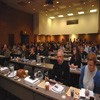Telling an Unfinished Story

During a forum hosted by the USC Shoah Foundation Institute, Los Angeles teachers compare a Holocaust survivor’s diary to his testimony a half century later.
By Pamela J. Johnson, USC College of Letters, Arts and Sciences
April 2008
Before dying of typhus in the Dutch concentration camp Bergen-Belsen, Anne Frank wrote in her world famous diary, “… in spite of everything I still believe that people are really good at heart.”
If Frank hadn’t perished at age 15 shortly before the end of World War II and the liberation of death camps, would her feelings about people have remained the same? How might her adult testimony differ?
About 200 Los Angeles-area secondary teachers considered these questions during a recent U.S. Holocaust Memorial Museum forum hosted by the USC Shoah Foundation Institute for Visual History and Education.
“One Man, Two Voices: Peter Feigl’s Diary and Testimony” was part of the two-day conference demonstrating how to teach about the Holocaust using survivors’ video testimony.
Part of USC College, the Shoah Foundation Institute has archives of nearly 52,000 videotaped testimonies from Holocaust survivors and other witnesses. The institute works with a network of partners to provide educational services around the world.
For this session, Sheila Hansen, the institute’s education manager, and her team worked with museum officials to present pages from a diary written by Peter Feigl as a young teen when his Jewish parents were arrested and eventually transported to Auschwitz, where they were killed.
The teachers compared a young Feigl’s diary to his videotaped testimony taken more than 50 years later.
“In the diary context, people are frozen in time,” Hansen told teachers during the April 4 session, adding that she discovered Feigl’s diary in Salvaged Pages: Young Writers’ Diaries of the Holocaust, by Alexandra Zapruder.
“[The diarists] are never allowed to change an opinion or an idea or build upon what they had said before.”
If Anne Frank had lived to give her testimony, Hansen asked, would she have validated everything she wrote in her diary?
“Or would she have, in fact, said, ‘Well, I was 14 and I was living in an attic,’ ” Hansen pondered. “ ‘I’ve changed.’ ”
In Peter Feigl’s neatly handwritten diary, the youngster appears to be a devout Catholic and talks about receiving Holy Communion and attending catechism. Living in a children’s colony in France, the boy explains that he is keeping the diary to record his life during his parent’s absence.
Sensing the rising threat of Nazism in Europe, Peter’s parents had their only child baptized as Catholic early on. He never knew any other religion. After his parents’ arrests, the youth went into hiding and as the threat against Jews escalated, he made a dangerous escape to Switzerland.
“The diary is very ‘in the moment,’ ” Hansen said. “He doesn’t know what’s coming. His testimony—which is obviously much, much later—is giving you the reflection he didn’t have when he was young. We get his young person’s view and his adult perspective looking back on those times.”
More than a half century later, Feigl predictably had changed. The 1997 video shows a distinguished-looking, reflective 68-year-old. By then Fleigl was a retired military equipment salesman who had worked for the U.S. Department of Defense. Married with two daughters, he was living in Palm City, Florida.
He was also now an atheist. When recalling the last time he saw his father, his brown, bespectacled eyes filled.
“As I watched him disappear over the crest of a hill, I suddenly was overcome with emotion and I felt that I would never see him again,” Feigl recalled of the day in 1942 when he was participating in a children’s summer camp.
He paused and cleared his throat. When he continued, his lips trembled.
“Indeed, a few days later the director of this [children’s] camp called me into her office and told me that my parents had been arrested.”
After the session, several participants said that the discussion, as well as the worksheets and other handouts, showed them how to use survivor diaries and testimonies as teaching tools in their classrooms.
Michelle Martinez and Coreen Adkisson, eighth-grade language arts teachers at Calle Mayor Middle School in Torrance, said the question of Anne Frank as an adult has often been raised in their classrooms.
“My students wonder if she had lived through the Holocaust, would she have felt the same way?” Martinez said. “This is an opportunity to take a similar situation and see what someone has to say all those years later. It’s really, really exciting. I can’t wait to use it in class.”
Other teachers said that history lessons on the Holocaust often focus too much on Hitler. They emphasized the importance of sharing the stories of the survivors. Having the survivor testify directly to viewers is ideal, they said.
“The emotions that come across make it more real for the students,” said Maritza Salazar, a world studies teacher at Garfield High School in Los Angeles. “It’s actually a person who was there; they felt it.”
Yvette Gow, special education teacher at Wilson Classical High School in Long Beach, said the testimonies are a crucial tool in helping to develop empathy in youths.
“When you build up an empathy for what these people went through, that can create a desire to take action,” Gow said. “It makes students want to become proactive.”
To view the hour-long version of Peter Feigl's testimony, click here.
Like this article? Get our e-newsletter.
Be the first to learn about new articles and personal stories like the one you've just read.